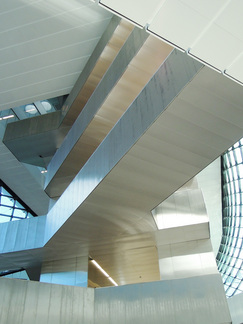-


Statoil Offices
After winning first prize in an open competition to design a new building for Norwegian energy producer Statoil, Oslo-based architectural practice a-lab found it had little time to celebrate.
Images courtesy of Luis Fonseca, a-lab and Ivan Brodey
Architect a-lab (Arkitekturlaboratoriet) Location Oslo - Norway Company involved Elval Colour Website http://www.elval-colour.com
Time was a key challenge of the project: a-lab secured the commission in March 2009 for the 65,500m² office building and 55,000m² of underground parking and technical areas, on the site of an old multi-storey car park on the Fornebu peninsula, near what was until the late 1990s the main Oslo airport, but is now a technology and business area.
Demolition of the car park started immediately. Design of the underground works was fast-tracked and started on site in early 2010. All major decisions regarding the foundation and construction of the office building had to be taken before the preliminary design was finished.
The building was inspired, says a-lab by the children’s game mikado (also known as pick-up sticks) in an effort minimise its footprint - while at the same time creating a flexible and stimulating workspace with views over the fjord from several elevations.
Sitting within a new five-hectare public park, the seemingly gravity defying Statoil building comprises five similarly constructed office modules, each three stories high, approx 140 metres long and 23 metres wide. Stacked on top of each other they together form a central climatised atrium and multipurpose space on the ground floor.
Northern Europe’s largest mobile crane had to be brought in for assembly of the vast steel trusses that enable the different office modules to cantilever up to an impressive 30 metres.
“Deconstruction of volumes gives great flexibility, as the office building can easily adapt to future needs of the tenant,” explains architect Benjamin Barth, and “the separation of volumes also allows more light into the building.”
The structure draws on construction techniques from the Norwegian off-shore industry, he says. The “office lamellas” are stacked on top of each other as self supportive, giant bridges, and the superstructure of steel trusses with concrete slabs supports a façade of 3x4m pre-fabricated aluminium composite cladding elements, with integrated insulation, triple-glazed windows and external sun protection.
The cladding is an Etalbond aluminium composite panel from Elval Colour, says Barth, chosen for being lightweight and for its stable properties. “It was also easy to manipulate, and form to our requirements”, he adds, while the white colour – standard RAL (9016) – “strengthens the light expression of the building and makes references to former airport activity on the site”.
The external profile developed especially for the project is, according to A-lab, “the key to the elegant and seamless facade expression...with no visible fixings in the entire prefabricated facade”. The profile includes a track for external solar shading, in the form of “traditional” blinds, as well as fixings for rain-screen cladding cassettes. These are made of powder coated aluminium sandwich panels folded to create 220mm deep cassettes, “giving the facades a deep relief and also shedding precipitation effectively”. A similar prefabricated façade system is used on the interior where the office lamellas overlook the acclimatised atrium.
The building’s self-supporting glass roof is double curved, and “spider-web-like” in its construction, while the “typically Nordic” interiors feature wood and stone, as well as aluminum.
In addition to the almost breathtaking audacity of its appearance, the building has a calculated energy use of just 103 kWh/m2, achieved through several methods, including using heat from the remote centralised heat source, 85% energy recycling and, of course, its well-insulated and airtight skin.
Images courtesy of Luis Fonseca, a-lab and Ivan Brodey























































